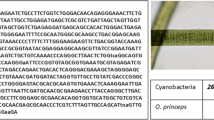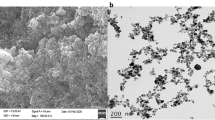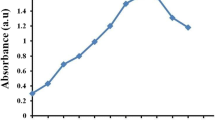Abstract
The present study explores the non-bactericidal anti-virulence efficacy of green synthesized silver nanoparticles (AgNPs) from Gelidiella acerosa against multi-drug resistant Vibrio spp. Spectral characterization of AgNPs was performed through UV-Visible, FT-IR, and energy-dispersive spectroscopic techniques followed by X-ray crystallography and zeta potential analysis. Further, the structural characterization was done by electron and atomic force microscopic techniques. AgNPs profoundly quelled the quorum sensing mediated violacein production in Chromobacterium violaceum and CV026. Characterized AgNPs at 100 μg mL−1 concentrations depicted a phenomenal anti-biofilm efficacy against Vibrio parahaemolyticus (71%) and Vibrio vulnificus (83%) biofilms, which was further confirmed through light, confocal, and scanning electron microscopic analyses. In vitro bioassays revealed the remarkable inhibitory values of AgNPs, by inhibiting the exopolysaccharide production, hydrophobicity, and motility. In vivo studies using Artemia franciscana larvae also confirmed the anti-infective proficiency, as the AgNPs effectively reduced the bacterial colonization and enhanced the survival rate of larvae up to 100% without any toxicity effect.

Rapid biosynthesized AgNPs from Gelidiella acerosa quench quorum sensing controlled virulence traits in vibrios








Similar content being viewed by others
References
Arumugam A, Karthikeyan C, Hameed SH, Gopinath K, Gowri S, Kavitha V (2015) Synthesis of cerium oxide nanoparticles using Gloriosa superba L. leaf extract and their structural, optical and antibacterial properties. Mater Sci Eng C Mater Biol Appl 49:408–415
Bhimba VB, Meenupriya J, Joel EL, Naveena ED, Kumar S, Thangaraj M (2010) Antibacterial activity and characterization of secondary metabolites isolated from mangrove plant Avicennia officinalis. Asian Pac J Trop Med 3:544–546
Bross MH, Soch K, Morales R, Mitchell RB (2007) Vibrio vulnificus infection: diagnosis and treatment. Am Fam Physician 76:539–544
Chakraborty N, Banerjee A, Lahiri S, Panda A, Ghosh AN, Pal R (2009) Biorecovery of gold using cyanobacteria and an eukaryotic alga with special reference to nanogold formation—a novel phenomenon. J Appl Phycol 21:145–152
Choi O, Yu CP, Fernandez G, Zhiqiang H (2010) Interactions of nanosilver with Escherichia coli cells in planktonic and biofilm cultures. Water Res 44:6095–6103
Choo JH, Rukayadi Y, Hwang JK (2006) Inhibition of bacterial quorum sensing by vanilla extract. Lett Appl Microbiol 42:637–641
Courtney HS, Ofek I, Penfound T (2009) Relationship between expression of the family of M proteins and lipoteichoic acid to hydrophobicity and biofilm formation in Streptococcus pyogenes. PLoS One 4:e4166
Defoirdt T, Benneche T, Brackman G, Coenye T, Sorgeloos P (2012) A quorum sensing-disrupting brominated thiophenone with promising therapeutic potential to treat luminescent vibriosis. PLoS One 7:e41788
Devi JS, Bhimba BV (2012) Anti-cancer activity of silver nanoparticles synthesized by the seaweed Ulva lactuca in vitro. Sci Reports 1:242
Divya KP, Dharuman V (2017) Supported binary liposome vesicle-gold nanoparticle for enhanced label free DNA and protein sensing. Biosens Bioelectron 95:168–173
Drake S, DePaola A, Jaykus L (2007) An overview of Vibrio vulnificus and Vibrio parahaemolyticus. Comprehen Rev Food Sci Food Saf 6:120–144
Duraikannu K, Rani KS, Anithajothi R, Umagowsalya G, Ramakritinan CM (2014) In vivo anticancer activity of red algae (Gelidiela acerosa and Acanthophora spicifera). Int J Pharm Sci Res 5:3347–3352
Elmahdi S, DaSilva LV, Parveen S (2016) Antibiotic resistance of Vibrio parahaemolyticus and Vibrio vulnificus in various countries: A review. Food Microbiol 57:128–134
Elsie BH, Dhanarajan MS (2010) Evaluation of antimicrobial activity and phytochemical screening of Gelidiella acerosa. J Pharm Sci Res 2:704–707
Faruque SM, Biswas K, Udden SM, Ahmad QS, Sack DA, Nair GB, Mekalanos JJ (2006) Transmissibility of cholera: in vivo-formed biofilms and their relationship to infectivity and persistence in the environment. Proc Natl Acad Sci 103:6350–6355
Gopinath K, Gowri S, Karthika V, Arumugam A (2014) Green synthesis of gold nanoparticles from fruit extract of Terminalia arjuna, for the enhanced seed germination activity of Gloriosa superb. J Nanostruct Chem 4:115
Gowrishankar S, Poornima B, Pandian SK (2014) Inhibitory efficacy of cyclo(Lleucyl-L-prolyl) from mangrove rhizosphere bacterium-Bacillus amyloliquefaciens (MMS-50) toward cariogenic properties of Streptococcus mutans. Res Microbiol 165:278–289
Gowrishankar S, Kamaladevi A, Ayyanar KS, Balamurugan K, Pandian SK (2015) Bacillus amyloliquefaciens-secreted cyclic dipeptide-cyclo(L-leucyl-L-prolyl) inhibits biofilm and virulence production in methicillin-resistant Staphylococcus aureus. RSC Adv 5:95788–95804
Gowrishankar S, Sivaranjani M, Kamaladevi A, Ravi AV, Balamurugan K, Pandian SK (2016) Cyclic dipeptide cyclo(l-leucyl-l-prolyl) from marine Bacillus amyloliquefaciens mitigates biofilm formation and virulence in Listeria monocytogenes. Pathog Dis 74:ftw017
Gurunathan S, Han JW, Kwon DN, Kim JH (2014) Enhanced antibacterial and anti-biofilm activities of silver nanoparticles against Gram-negative and Gram-positive bacteria. Nanoscale Res Lett 9:373
Haendiges J, Timme R, Allard MW, Myers RA, Brown EW, Gonzalez-Escalona N (2015) Characterization of Vibrio parahaemolyticus clinical strains from Maryland (2012-2013) and comparisons to a locally and globally diverse V. parahaemolyticus strains by whole-genome sequence analysis. Front Microbiol 6:125
Kalishwaralal K, BarathManiKanth S, Pandian SR, Deepak V, Gurunathan S (2010) Silver nanoparticles impede the biofilm formation by Pseudomonas aeruginosa and Staphylococcus epidermidis. Colloids Surf B: Biointerfaces 79:340–344
Kannan RRR, Stirk WA, Van Staden J (2013) Synthesis of silver nanoparticles using the seaweed Codium capitatum P.C. Silva (Chlorophyceae). South African J Bot 86:1–4
Khan MSA, Zahin M, Hasan S, Husain FM, Ahmad I (2009) Inhibition of quorum sensing regulated bacterial functions by plant essential oils with special reference to clove oil. Lett Appl Microbiol 49:354–359
LewisOscar F, MubarakAli D, Nithya C, Priyanka R, Gopinath V, Alharbi NS, Thajuddin N (2015) One pot synthesis and anti-biofilm potential of copper nanoparticles (CuNPs) against clinical strains of Pseudomonas aeruginosa. Biofouling 4:379–391
Martinez JL (2008) Antibiotics and antibiotic resistance genes in natural environments. Science 321:365–367
Matsumoto C, Okuda J, Ishibashi M, Iwanaga M, Garg P, Ramamurthy T, Wong HC, Depaola A, Kim YB, Albert MJ, Nishibuchi M (2000) Pandemic spread of an O3:K6 clone of Vibrio parahaemolyticus and emergence of related strains evidenced by arbitrarily primed PCR and toxRS sequence analyses. J Clin Microbiol 38:578–585
Megha MN, Anjali SB (2013) Antioxidant potential of seaweeds from Kunakeshwar along the west coast Maharashtra. Asian J Biomed Pharm Sci 3:45–50
Mishra YK, Mohapatra S, Chakravadhanula VS, Lalla NP, Zaporojtchenko V, Avasthi DK, Faupel F (2010) Synthesis and characterization of Ag-polymer nanocomposites. J Nanoscie Nanotechnol 10:2833–2837
Mohanty S, Mishra S, Jena P, Jacob B, Sarkar B, Sonawane A (2012) An investigation on the antibacterial, cytotoxic, and antibiofilm efficacy of starch-stabilized silver nanoparticles. Nanomed: Nanotechnol Biol Med 8:916–924
Nair GB, Ramamurthy T, Bhattacharya SK, Dutta B, Takeda Y, Sack DA (2007) Global dissemination of Vibrio parahaemolyticus serotype O3:K6 and its serovariants. Clin Microbiol Rev 20:39–48
Newton A, Kendall M, Vugia DJ, Henao OL, Mahon BE (2012) Increasing rates of vibriosis in the United States, 1996-2010: review of surveillance data from 2 systems. Clin Infect Dis 54:391–395
Nithya C, Pandian SK (2010) The in vitro antibiofilm activity of selected marine bacterial culture supernatants against Vibrio spp. Arch Microbiol 192:843–854
Nithyanand P, Shafreen RMB, Muthamil S, Pandian SK (2015) Usnic acid, a lichen secondary metabolite inhibits Group A Streptococcus biofilms. Antonie Van Leeuwenhoek 107:263–272
Oliver JD (2006) Vibrio vulnificus. In: Thompson FL, Austin B, Swings J (eds) Biology of vibrios. ASM Press, Washington, DC, pp 349–366
Packiavathy IASV, Sasikumar P, Pandian SK, Ravi AV (2013) Prevention of quorum sensing mediated biofilm development and virulence factors production in Vibrio spp. by curcumin. Appl Microbiol Biotechnol 97:10177–10187
Priebe M, Widmer J, Lowa NS, Abram S, Mottas I, Woischnig A, Brunetto PS, Khanna N, Bourquin C, Fromm KM (2017) Antimicrobial silver-filled silica nanorattles with low immunotoxicity in dendritic cells. Nanomed: Nanotechnol Biol Med 13:11–22
Rajalaxmi M, Shafreen RB, Iyer PM, Vino RS, Balamurugan K, Pandian SK (2016) An in silico, in vitro and in vivo investigation of indole-3-carboxaldehyde identified from the seawater bacterium Marinomonas sp. as an antibiofilm agent against Vibrio cholerae O1. Biofouling 32:1–12
Ralston EP, Kite-Powell H, Beet A (2011) An estimate of the cost of acute health effects from food- and water-borne marine pathogens and toxins in the USA. J Water Health 9:680–694
Rasch M, Buch C, Austin B, Slierendrecht WJ, Ekmann KS, Larsen JL, Johansen C, Riedel K, Eberl L, Givskov M, Gram L (2004) An inhibitor of bacterial quorum sensing reduces mortalities caused by vibriosis in rainbow trout (Oncorhynchus mykiss, Walbaum). Syst Appl Microbiol 27:350–359
Salini R, Sindhulakshmi M, Poongothai T, Pandian SK (2015) Inhibition of quorum sensing mediated biofilm development and virulence in uropathogens by Hyptis suaveolens. A Van Leeuw J Microb 107:1095–1106
Santhakumari S, Kannappan AR, Pandian SK, Thajuddin N, Rajendran RB, Ravi AV (2016) Inhibitory effect of marine cyanobacterial extract on biofilm formation and virulence factor production of bacterial pathogens causing vibriosis in aquaculture. J Appl Phycol 28:313–324
Sarkar R, Chaudhary SK, Sharma A, Yadav KY, Nema NK, Sekhoacha M, Karmakar S, Braga FC, Matsabisa MG, Mukherjee PK, Sen T (2014) Antibiofilm activity of Marula—a study with the standardized bark extract. J Ethnopharmacol 154:170–175
Satapathy S, Shukla SP, Sandeep KP, Singh AR, Sharma N (2015) Evaluation of the performance of an algal bioreactor for silver nanoparticle production. J Appl Phycol 27:285–291
Satish L, Rameshkumar R, Rathinapriya P, Pandian S, Rency AS, Sunitha T, Ramesh M (2015) Effect of seaweed liquid extracts and plant growth regulators on in vitro mass propagation of brinjal (Solanum melongena L.) through hypocotyl and leaf disc explants. J Appl Phycol 27:993–1002
Satish L, Rathinapriya P, Rency AS, Ceasar SA, Pandian S, Rameshkumar R, Ramesh M (2016) Somatic embryogenesis and regeneration using Gracilaria edulis and Padina boergesenii seaweed liquid extracts and genetic fidelity in finger millet (Eleusine coracana). J Appl Phycol 28:2083–2098
Seil JT, Webster JT (2012) Antimicrobial applications of nanotechnology: methods and literature. Int J Nanomedicine 7:2767–2781
Shanmugam N, Rajkamal P, Cholan S, Kannadasan N, Sathishkumar K, Viruthagiri G, Sundaramanickam A (2014) Biosynthesis of silver nanoparticles from the marine seaweed Sargassum wightii and their antibacterial activity against some human pathogens. Appl Nanosci 4:881–888
Srinivasan R, Devi KR, Kannappan A, Pandian SK, Ravi AV (2016) Piper betle and its bioactive metabolite phytol mitigates quorum sensing mediated virulence factors and biofilm of nosocomial pathogen Serratia marcescens in vitro. J Ethnopharmacol 193:592–603
Suganthy N, Nisha SA, Pandian SK, Devi KP (2013) Evaluation of Gelidiella acerosa, the red algae inhabiting South Indian coastal area for antioxidant and metal chelating potential. Biomed Prev Nutr 3:399–406
Syad AN, Shunmugiah KP, Kasi PD (2012) Assessment of anticholinesterase activity of Gelidiella acerosa: implications for its therapeutic potential against Alzheimer’s disease. Evid Based Comp Alt Med 2:1–8
Syad AN, Rajamohamed BS, Shunmugaiah KP, Kasi PD (2016) Neuroprotective effect of the marine macroalga Gelidiella acerosa: identification of active compounds through bioactivity-guided fractionation. Pharm Biol 2:1–9
Thenmozhi R, Nithyanand P, Rathna J, Pandian SK (2009) Antibiofilm activity of coral-associated bacteria against different clinical M serotypes of Streptococcus pyogenes. FEMS Immunol Med Microbiol 57:284–294
Vaseeharan B, Ramasamy P, Chen JC (2010) Antibacterial activity of silver nanoparticles (AgNps) synthesized by tea leaf extracts against pathogenic Vibrio harveyi and its protective efficacy on juvenile Feneropenaeus indicus. Lett Appl Microbiol 50:352–356
Wang C, Clark CG, Liu C, Pucknell C, Munro CK, Kruk TM, Caldeira R, Woodward DL, Rodgers FG (2003) Detection and characterization of the hemolysin genes in Aeromonas hydrophila and Aeromonas sobria by multiplex PCR. J Clin Microbiol 41:1048–1054
Whitaker WB, Richards GP, Boyd EF (2014) Loss of sigma factor RpoN increases intestinal colonization of Vibrio parahaemolyticus in an adult mouse model. Infect Immun 82:544–556
Wright GD (2007) The antibiotic resistome: the nexus of chemical and genetic diversity. Nat Rev Micro 5:175–186
You JL, Xue XL, Cao LX, Lu X, Wang J, Zhang LX, Zhou SN (2007) Inhibition of Vibrio biofilm formation by a marine actinomycete strain A66. Appl Microbiol Biotechnol 76:1137–1144
Acknowledgements
The author L. Satish sincerely thanks the University Grants Commission, New Delhi, Government of India for financial support in the form of UGC BSR SRF (UGC order no. F.4-1/2006 (BSR)/7-326/2011/BSR, dated 25 February 2013). The author S. Santhakumari gratefully acknowledges the Department of Biotechnology, Government of India (Grant No. BT/PR4815/AAQ/3/587/2012), for the financial support in the form of DBT-SRF. Also, the authors gratefully acknowledge the computational and bioinformatics facility provided by the Alagappa University Bioinformatics Infrastructure Facility (funded by Department of Biotechnology, Government of India; Grant No. BT/BI/25/001/2006). The funders had no role in experimental design, data collection and analysis, writing of the manuscript, or decision to publish this work.
Author information
Authors and Affiliations
Corresponding author
Ethics declarations
Competing interests
There are no conflicts of interest with this work.
Additional information
Responsible editor: Philippe Garrigues
Electronic supplementary material
ESM 1
(DOC 7407 kb).
Rights and permissions
About this article
Cite this article
Satish, L., Santhakumari, S., Gowrishankar, S. et al. Rapid biosynthesized AgNPs from Gelidiella acerosa aqueous extract mitigates quorum sensing mediated biofilm formation of Vibrio species—an in vitro and in vivo approach. Environ Sci Pollut Res 24, 27254–27268 (2017). https://doi.org/10.1007/s11356-017-0296-4
Received:
Accepted:
Published:
Issue Date:
DOI: https://doi.org/10.1007/s11356-017-0296-4




